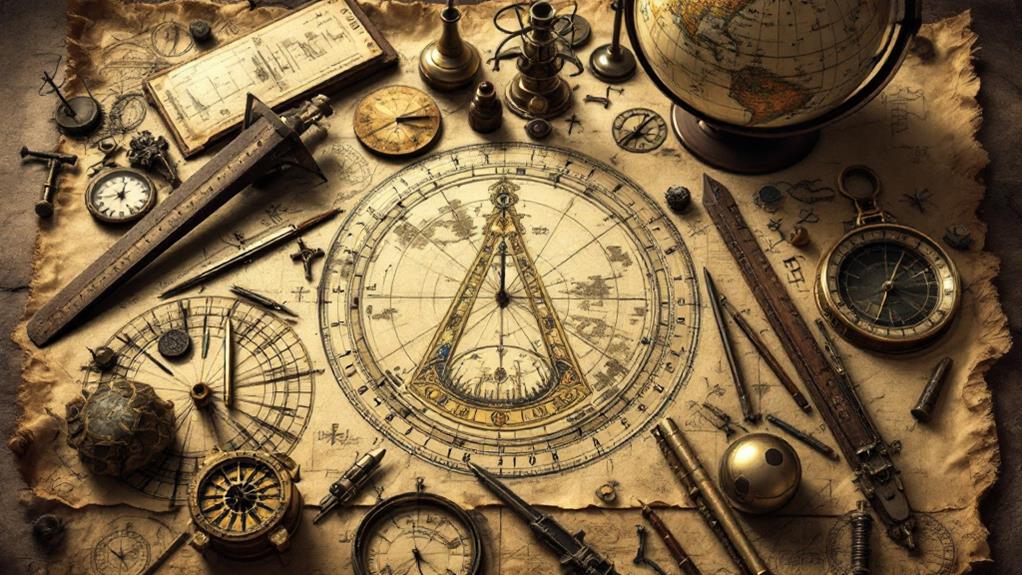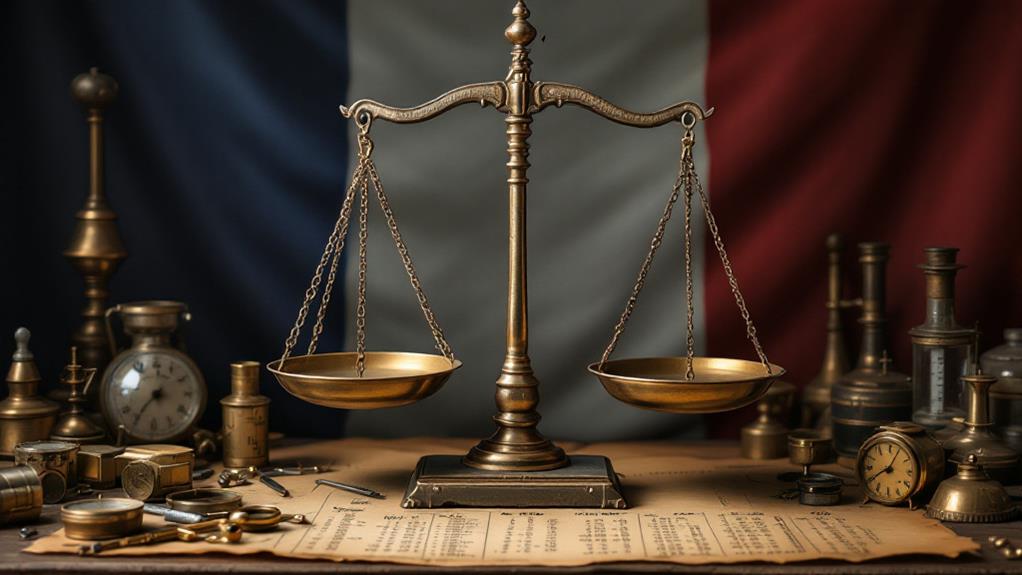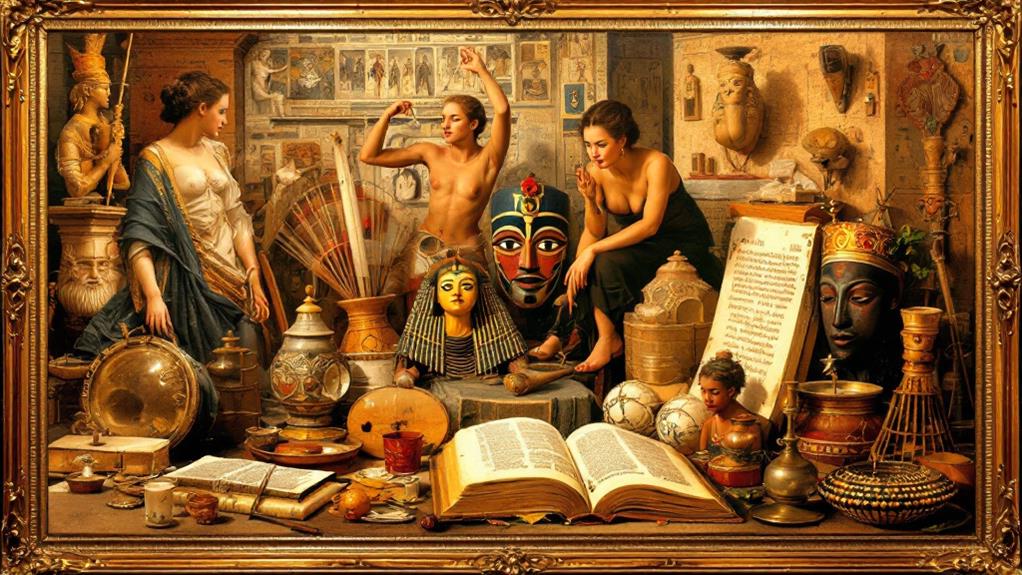The History of Metrology: How We Measure the World

Metrology, the science of measurement, has evolved dramatically over millennia. You've likely encountered various measurement systems, from ancient Egyptian cubits to today's precise atomic clocks. The quest for standardization led to the rise of imperial units and the metric system, with the French Revolution sparking a scientific revolution in measurement. As industry grew, so did the need for uniform standards across borders. The development of atomic clocks brought unparalleled accuracy, while the SI system continues to adapt to new findings. From barleycorns to quantum sensors, the expedition of metrology reflects humanity's enduring drive to quantify our world with ever-increasing precision.
Ancient Measurement Systems
Countless ancient civilizations developed their own measurement systems, each uniquely suited to their needs and environment. You'll find that these early systems often relied on human body parts or everyday objects as references. For instance, the ancient Egyptian cubit was based on the length of a forearm, while the Mesopotamians used barleycorns to measure small distances.
One of the most influential ancient systems came from the Babylonians. Their sexagesimal (base-60) system is still reflected in how we measure time and angles today. Early Babylonian units included the mina for weight and the kùš for length, which were standardized across their empire.
As you scrutinize ancient metrology, you'll notice that many cultures developed similar units independently. The foot, for example, was used in various forms across Europe and Asia. These systems weren't always precise by modern standards, but they served their purposes well. They allowed for trade, construction, and land measurement within their respective societies. Over time, these diverse systems would evolve, merge, and eventually give way to more standardized methods of measurement.
The Rise of Imperial Units
As ancient measurement systems gradually evolved, a new standardized approach emerged in the form of imperial units. You'll find that these units gained prominence in England during the Middle Ages, eventually spreading across the British Empire. The adoption of imperial standards brought much-needed consistency to trade and everyday life.
You might recognize some of these imperial units: inches, feet, yards, and miles for length; ounces and pounds for weight; and pints, quarts, and gallons for volume. These measuring imperial distinctions became deeply ingrained in British culture and were later exported to colonies worldwide.
The British Weights and Measures Act of 1824 officially established the imperial system, defining units based on physical prototypes. You'd have seen this system used extensively in commerce, engineering, and daily life throughout the empire. Even as other countries adopted metric standards, imperial units persisted in many former British territories.
Today, you'll still encounter imperial units in countries like the United States and the United Kingdom, where they continue to coexist with metric measurements in various applications.
French Revolution and the Metric

During the tumultuous years of the French Revolution, a radical shift in measurement systems took place. You might be surprised to learn that this political upheaval sparked a scientific revolution in metrology. The French Academy of Sciences proposed a new, rational system based on the decimal system implementation. This metric system aimed to standardize measurements across France and eventually the world.
The metric system's beauty lay in its simplicity. It used base-10 units, making calculations easier than with traditional systems. The meter became the foundation, defined as one ten-millionth of the distance from the North Pole to the equator. Other units, like the kilogram and liter, were derived from the meter.
However, adoption challenges were significant. Many citizens resisted change, clinging to familiar units. The government faced opposition from traders and craftsmen who feared economic disruption. Despite these obstacles, France officially adopted the metric system in 1795. It took decades for full implementation, but the system's logic eventually won out. Today, you use metric units in nearly every aspect of your life, a legacy of this revolutionary period in metrology.
Standardization in the Industrial Age
The Industrial Revolution's rapid growth sparked a fresh chapter in measurement standardization. As factories and mass production techniques flourished, you'd find a pressing need for uniform measurements across industries. This era saw the rise of precision instruments and the refinement of existing measurement systems.
You'll notice these key developments during this period:
- Adoption of standardized gauges and tools
- Creation of national standards institutions
- Development of more accurate measuring devices
- Establishment of international measurement conventions
- Integration of metrology into factory automation processes
With the advent of assembly lines and interchangeable parts, consistent measurements became vital. You'd see industries pushing for tighter tolerances and more precise calibration methods. The need for standardization extended beyond national borders, leading to international collaborations on measurement systems.
As you explore deeper into this era, you'll uncover how metrology played a crucial role in quality control and efficiency. The standardization efforts during the Industrial Age laid the groundwork for modern measurement systems, enabling the global trade and technological advancements you experience today.
International Bureau of Weights

Building on the momentum of international collaboration in metrology, the establishment of the International Bureau of Weights and Measures (BIPM) in 1875 marked a significant milestone. You'll find that this international standards organization played a pivotal role in unifying measurement systems worldwide. The BIPM's creation stemmed from the need to maintain and disseminate uniform standards across nations, ensuring scientific and commercial activities could operate on a level playing field.
As you investigate the BIPM's history, you'll uncover its impact on global metrology initiatives. It's been instrumental in developing and maintaining the International System of Units (SI), which you now use in your daily life. The BIPM's work has touched various fields, from precise time-keeping to defining fundamental constants. You'll appreciate how it's promoted cooperation among national metrology institutes, leading to more accurate and consistent measurements worldwide. Through its efforts, you've seen the evolution of measurement standards, from physical artifacts to quantum-based definitions. The BIPM continues to adapt to technological advancements, ensuring that metrology remains relevant and precise in our increasingly interconnected world.
Atomic Clocks and Precision
Revolutionizing timekeeping, atomic clocks emerged as a pinnacle of exactitude in metrology. You'll find these incredible devices at the heart of modern timekeeping, offering unparalleled precision. They're based on the vibrations of atoms, typically cesium, and can measure time to within a second over millions of years.
Atomic clocks have transformed various fields:
- Global Positioning Systems (GPS)
- Telecommunications
- Scientific research
- Financial transactions
- Space exploration
You'll see their impact in everyday life, from synchronizing cell phone networks to coordinating international flight schedules. As technology advances, atomic clocks continue to improve. Quantum sensors now push the boundaries of precision even further, allowing for measurements at the atomic scale.
Essential components, ultra stable oscillators, guarantee the clock's stability over long periods. These oscillators maintain the frequency of the atomic transitions, providing the foundation for the clock's extraordinary precision.
You're witnessing a new chapter in metrology, where time measurement has reached unparalleled levels of precision. As atomic clocks evolve, they'll continue to shape our understanding of the universe and drive technological innovations across numerous industries.
The SI System Today

Developing from its roots in 18th-century France, the International System of Units (SI) has become the global standard for measurement. Today, you'll find the SI system used in scientific, commercial, and everyday applications worldwide. It consists of seven base units: the meter, kilogram, second, ampere, kelvin, mole, and candela. These form the foundation for all other derived units of measurement.
In recent years, you've seen significant advancements in measuring techniques that have led to more precise definitions of SI units. For instance, the kilogram is no longer defined by a physical artifact but by the Planck constant. This shift to universal constants guarantees greater stability and reproducibility in measurements.
The SI system continues to evolve, adapting to new scientific discoveries and technological innovations. You'll notice its impact in fields ranging from nanotechnology to space exploration. As measuring devices become more sophisticated, the SI system provides a consistent blueprint for comparing and communicating results across borders and disciplines. By using the SI system, you're participating in a global effort to standardize and improve our understanding of the physical world.
Future of Measurement Technology
As measurement technology continues to advance, you'll see pioneering developments that expand the frontiers of precision and accuracy. Measurement convergence will blur the lines between physical and digital sensing, revolutionizing how we quantify our world. You'll witness the integration of quantum technologies, artificial intelligence, and nanotechnology in metrology, pushing the boundaries of what's measurable.
The future of measurement holds exciting possibilities:
- Atomic clocks with unparalleled accuracy
- Self-calibrating sensors for real-time adjustments
- Quantum-based measurements for fundamental constants
- AI-driven data analysis for complex measurements
- Nanoscale probes for molecular-level precision
You'll encounter a shift towards digital sensing, where smart devices and IoT networks create vast measurement ecosystems. This interconnectedness will enable real-time monitoring and adaptive measurement strategies across various fields. As measurement technology evolves, you'll see increased reliance on software-defined instruments that can adapt to diverse measurement needs.
The future also promises advancements in wearable metrology, allowing you to measure personal health metrics with clinical precision. You'll experience a world where measurement technology seamlessly integrates into your daily life, enhancing decision-making and understanding of your environment.



